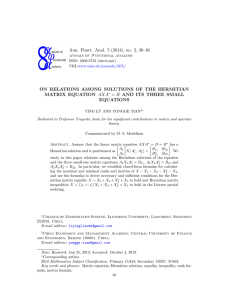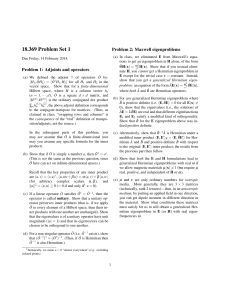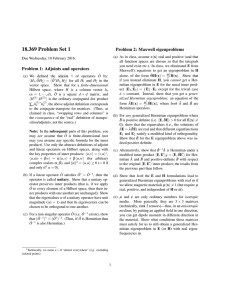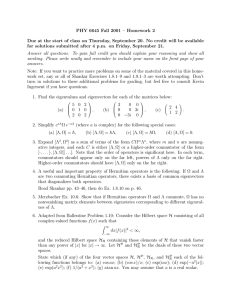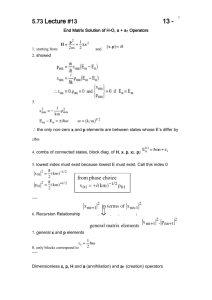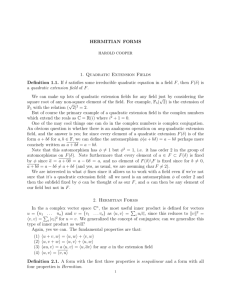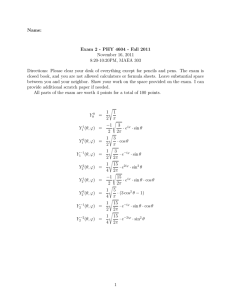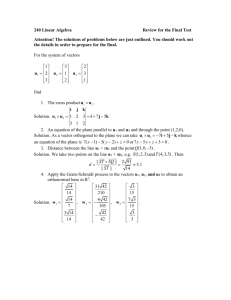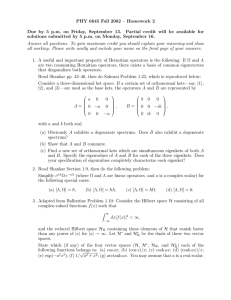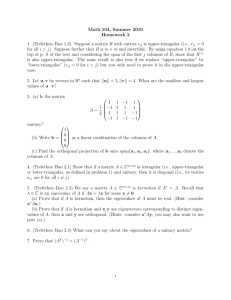18.369 Problem Set 1 Solutions
advertisement
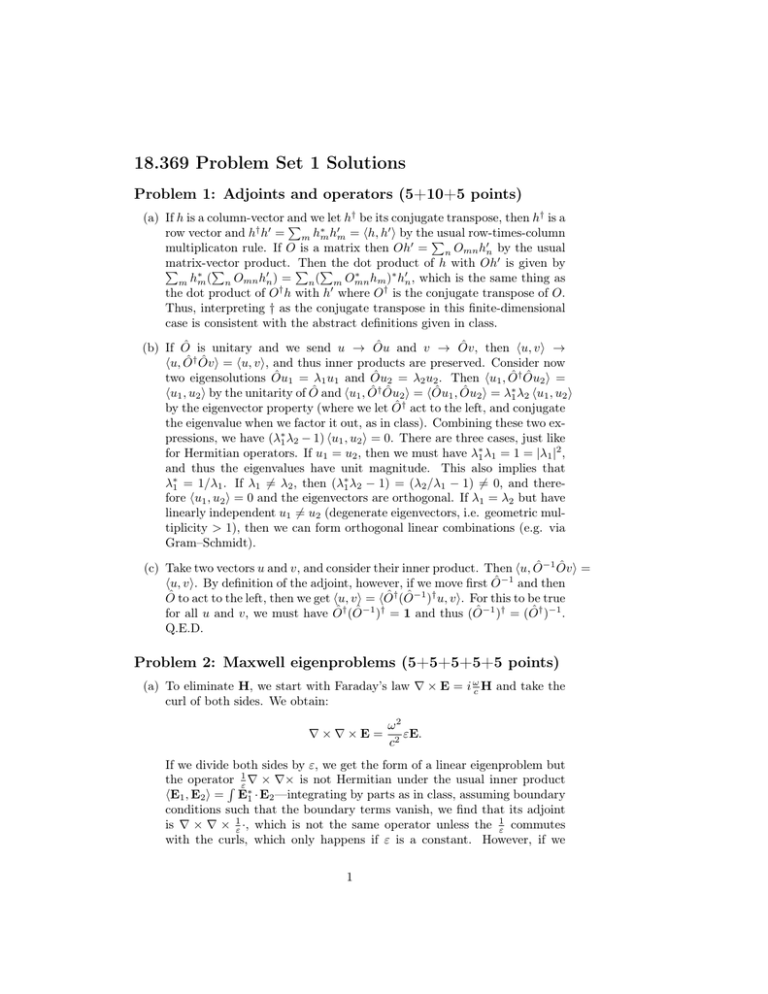
18.369 Problem Set 1 Solutions Problem 1: Adjoints and operators (5+10+5 points) † † (a) If h is a column-vector and P we∗ let0 h be its0 conjugate transpose, then h is a † 0 row vector and h h = m hm hm = hh, h i by theP usual row-times-column multiplicaton rule. If O is a matrix then Oh0 = n Omn h0n by the usual matrix-vector product. P Then product of h with Oh0 is given by P P Pthe dot ∗ 0 ∗ ∗ 0 m hm ( n Omn hn ) = n( m Omn hm ) hn , which is the same thing as † 0 † the dot product of O h with h where O is the conjugate transpose of O. Thus, interpreting † as the conjugate transpose in this finite-dimensional case is consistent with the abstract definitions given in class. (b) If Ô is unitary and we send u → Ôu and v → Ôv, then hu, vi → hu, Ô† Ôvi = hu, vi, and thus inner products are preserved. Consider now two eigensolutions Ôu1 = λ1 u1 and Ôu2 = λ2 u2 . Then hu1 , Ô† Ôu2 i = hu1 , u2 i by the unitarity of Ô and hu1 , Ô† Ôu2 i = hÔu1 , Ôu2 i = λ∗1 λ2 hu1 , u2 i by the eigenvector property (where we let Ô† act to the left, and conjugate the eigenvalue when we factor it out, as in class). Combining these two expressions, we have (λ∗1 λ2 − 1) hu1 , u2 i = 0. There are three cases, just like for Hermitian operators. If u1 = u2 , then we must have λ∗1 λ1 = 1 = |λ1 |2 , and thus the eigenvalues have unit magnitude. This also implies that λ∗1 = 1/λ1 . If λ1 6= λ2 , then (λ∗1 λ2 − 1) = (λ2 /λ1 − 1) 6= 0, and therefore hu1 , u2 i = 0 and the eigenvectors are orthogonal. If λ1 = λ2 but have linearly independent u1 6= u2 (degenerate eigenvectors, i.e. geometric multiplicity > 1), then we can form orthogonal linear combinations (e.g. via Gram–Schmidt). (c) Take two vectors u and v, and consider their inner product. Then hu, Ô−1 Ôvi = hu, vi. By definition of the adjoint, however, if we move first Ô−1 and then Ô to act to the left, then we get hu, vi = hÔ† (Ô−1 )† u, vi. For this to be true for all u and v, we must have Ô† (Ô−1 )† = 1 and thus (Ô−1 )† = (Ô† )−1 . Q.E.D. Problem 2: Maxwell eigenproblems (5+5+5+5+5 points) (a) To eliminate H, we start with Faraday’s law ∇ × E = i ωc H and take the curl of both sides. We obtain: ∇×∇×E= ω2 εE. c2 If we divide both sides by ε, we get the form of a linear eigenproblem but 1 the operator R ε ∗∇ × ∇× is not Hermitian under the usual inner product hE1 , E2 i = E1 · E2 —integrating by parts as in class, assuming boundary conditions such that the boundary terms vanish, we find that its adjoint is ∇ × ∇ × 1ε ·, which is not the same operator unless the 1ε commutes with the curls, which only happens if ε is a constant. However, if we 1 leave it in the form above we have a generalized Hermitian problem with  = ∇ × ∇× and B̂ = ε .  is Hermitian for the same reason that Θ̂ was (it is Θ̂ for ε = 1), and B̂ is Hermitian as long as ε is real (so that H∗1 · εH2 = (εH1 )∗ · H2 ). (b) The proof follows the same lines as in class. Consider two eigensolutions u1 and u2 (where Âu = λB̂u, and u 6= 0), and take hu2 , Âu1 i. Since  is Hermitian, we can operate it to the left or to the right in the inner product, and get λ∗2 hu2 , B̂u1 i = λ1 hu2 , B̂u1 i, or (λ∗2 − λ1 ) hu2 , B̂u1 i = 0. There are three cases. First, if u1 = u2 then we must have λ1 = λ∗1 (real eigenvalues), since hu1 , B̂u1 i > 0 by definition if B̂ is positive definite. Second, if λ1 6= λ2 then we must have hu2 , B̂u1 i = 0, which is our modified orthogonality condition. Finally, if λ1 = λ2 but u1 6= u2 , then we can form a linear combination that is orthogonal (since any linear combination still is an eigenvector); e.g. u2 → u2 − u1 hu2 , B̂u1 i hu1 , B̂u1 i , where we have again relied on the fact that B̂ is positive definite (so that we canR divide by hu1 , B̂u1 i). This is certainly true for B̂ = ε, since hE, B̂Ei = ε|E|2 > 0 for all E 6= 0 (almost everywhere) as long as ε > 0 as we assumed in class. (c) First, let us verify that hE, E0 iB = hE, B̂E0 i is indeed an inner product. Because B̂ is self-adjoint, we have hE0 , EiB = hE0 , B̂Ei = hB̂E0 , Ei = hE, B̂E0 i∗ = hE, E0 i∗B . Bilinearity follows from bilinearity of h·, ·i and linearity of B̂. Positivity hE, EiB = hE, B̂Ei > 0 except for E = 0 (almost everywhere) follows from positive-definiteness of B̂. All good! Now, Hermiticity of B̂ −1  follows almost trivially from Hermiticity of  0 −1 ÂE i = hÂE, E0 i = hÂE, B̂ −1 B̂E0 i = B̂ B̂ and B̂: hE, B̂ −1 ÂE0 iB = hE, 0 0 −1 −1 hB̂ ÂE, B̂E i = hB̂ ÂE, E iB , where we have used the fact, from problem 1, that Hermiticity of B̂ implies Hermiticity of B̂ −1 . Q.E.D. (d) If µ 6= 1 then we have B = µH 6= H, and when we eliminate E or H from Maxwell’s equations we get: 1 ω2 ∇ × ∇ × H = 2 µH ε c ∇× ω2 1 ∇ × E = 2 εE µ c with the constraints ∇ · εE = 0 and ∇ · µH = 0. These are both generalized Hermitian eigenproblems (since µ and ∇ × µ1 ∇× are both Hermitian operators for the same reason ε and ∇× 1ε ∇× were). Thus, the eigenvalues are real and the eigenstates are orthogonal through µ and ε, respectively, 2 as proved above. To prove that ω is real, we consider an eigenfunction H. 2 Then hH, Θ̂Hi = ωc2 hH, µHi and we must have ω 2 ≥ 0 since Θ̂ is positive semi-definite (from class) and µ is positive definite (for the same reason ε was, above). The E eigenproblem has real ω for the same reason (except that µ and ε are swapped). Alternatively, as in part (c), we can write them as ordinary Hermitian eigenproblems with a modified inner product, e.g. 1ε ∇ × µ1 ∇ × E = ω2 c2 E, where 1ε ∇ × µ1 ∇× is Hermitian and positive semidefinite under the R hE, E0 iB = E∗ · εE0 inner product as above. The results then follow. (e) Consider the H eigenproblem. (To even get this linear eigenproblem, we must immediately require ε to be an invertible matrix, and of course require ε and µ to be independent of ω or the field R strength.) RFor the righthand operator µ to be Hermitian, we require H∗1 · µH2 = (µH1 )∗ · H2 for all H1 and H2 , which implies that H∗1 · µH2 = (µH1 )∗ · H2 . Thus, we require the 3 × 3 µ(x) matrix to be itself Hermitian at every x (that is, equal to its conjugate transpose, from problem 1). (Technically, these requirements hold “almost everywhere” rather than at every point, but as usual I willR gloss over thisR distinction.) Similarly, for Θ̂ to be Hermitian we require F∗1 ·ε−1 F2 = (ε−1 F1 )∗ ·F2 where F = ∇×H, so that we can move the ε−1 over to the left side of the inner product, and thus ε−1 (x) must be Hermitian at every x. From problem 1, this implies that ε(x) is also Hermitian. Finally, to get real R eigenvalues we saw from above that we must have µ positive definite ( H∗ · µH > 0 for H 6= 0); since this must be true for all H then µ(x) at each point must be a positive-definite 3 × 3 matrix (positive eigenvalues). Similarly, Θ̂ must be positive semi-definite, which implies that ε−1 (x) is positive semi-definite (non-negative eigenvalues), but since it has to be invertible we must have ε(x) positive definite (zero eigenvalues would make it singular). To sum up, we must have ε(x) and µ(x) being positive-definite Hermitian matrices at (almost) every x. (The analysis for the E eigenproblem is identical.) Technically, there are a couple other possibilities. In part (b), we showed that if B̂ is positive-definite it leads to real eigenvalues etc. The same properties, however, hold if B̂ is negative-definite, and if both  and B̂ are negative-definite we still get real, positive eigenvalues. Thus, another possibility is for ε and µ to be Hermitian negative-definite matrices. (For a scalar ε < 0 and µ < 0, this leads to materials with a negative real √ index of refraction n = − εµ!) Furthermore, ε and µ could both be anti Hermitian instead of Hermitian (i.e., ε† = −ε and µ† = −µ), although I’m not aware of any physical examples of this. More generally, for any complex number z, if we replace ε and µ by zε and µ/z, then ω is unchanged (e.g. making z = i gives anti-Hermitian matrices). 3
